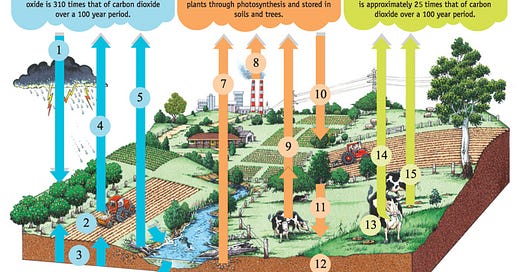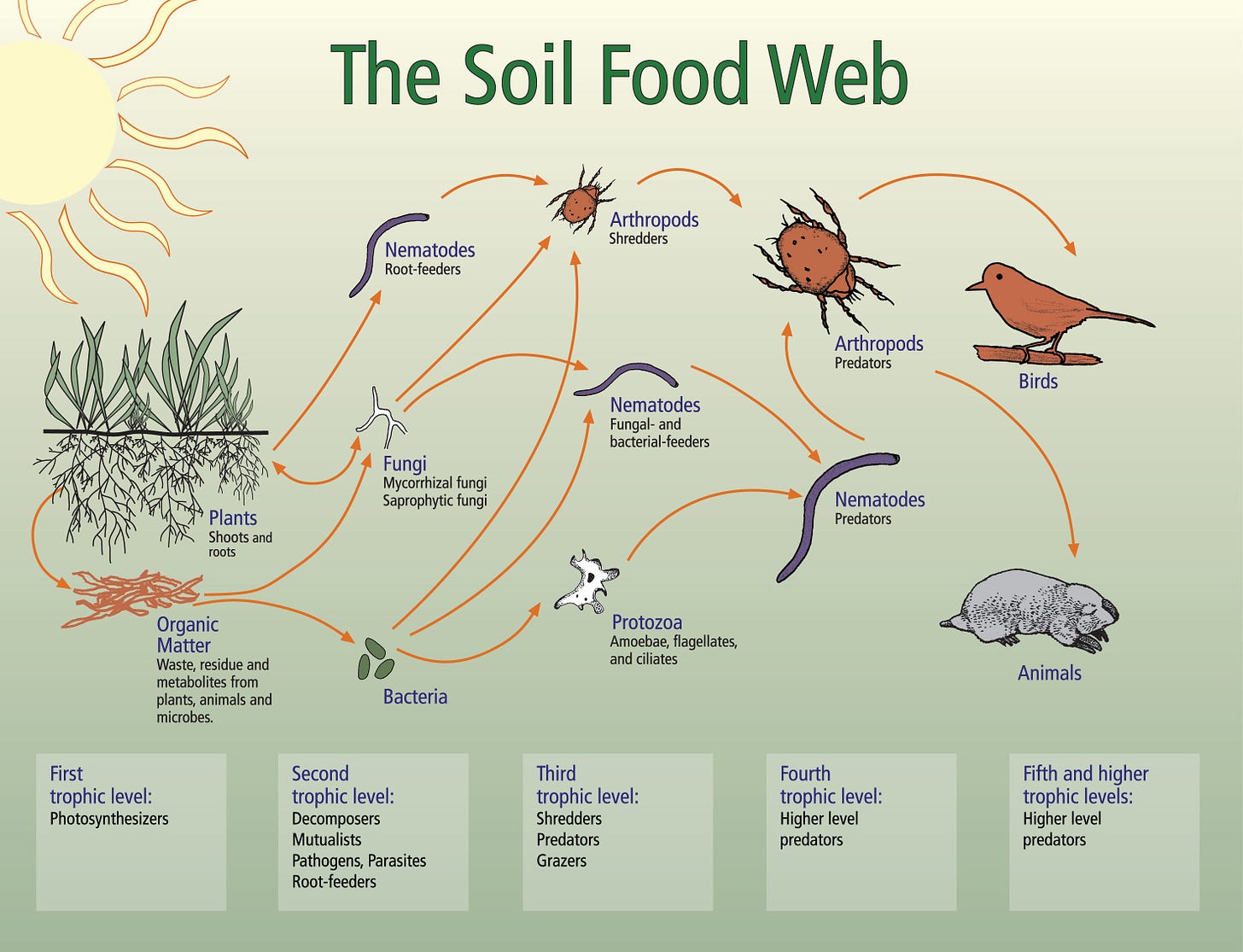How can farming heal soils and improve climate resiliency?
How can farming heal soils and improve climate resiliency?
This is a primary line of inquiry for Biota Coffee, but before we dive into this topic, we should take a step back to consider the context in which we ask the question.
Farming: A net contributor to greenhouse gases
In the context of rising greenhouse gases (GHGs) and their deleterious effects on our planet’s climate, we would expect to be able to count on farming as a tool to reduce or reverse this buildup of carbon dioxide (CO2), methane (CH4), nitrous oxide (N2), and ozone (O3) in the atmosphere.
After all, as we all learned in grade school, photosynthesis is the process by which plants use sunlight to synthesize foods from CO2 and water, and release oxygen as part of their respiration process. All plants, including those farmed in agriculture, remove some amount of carbon from the atmosphere.
Yet today, the predominant model of industrial agriculture has actually converted farming into a net contributor of GHGs.
There are several mechanisms by which this occurs. For example, industrial agriculture is heavily reliant on fossil fuels, both to run the heavy machinery responsible for plowing, tilling, irrigating, and spraying fertilizers, as well as the manufacture of synthetic fertilizers. Thus, even when accounting for the GHG’s that crops remove from the air, the various activities around the cultivation of those crops can add other GHG’s at a higher rate.
A more primary mechanism by which conventional agriculture contributes to GHG emissions, however, is through tillage. When farmers till the soil, they rip up and destroy a complex and interconnected community of soil organisms and microorganisms that are responsible for cycling nutrients through that system. When this network is destroyed, one of our most important atmospheric carbon sinks is destroyed as well.
Healing the soil microcosmos
Let’s meet the primary players in this underground soil symphony.
The most fundamental microorganisms in the soil are bacteria, which are efficient decomposers of simply-structured soil organic material (i.e. simple sugars). The vast diversity and hardiness of bacteria means that they can survive in all but the most severely depleted soils. However, the carbon-to-nitrogen ratio of bacteria is around 5:1, meaning that they can only hold five carbon molecules for every nitrogen molecule in their bodies.
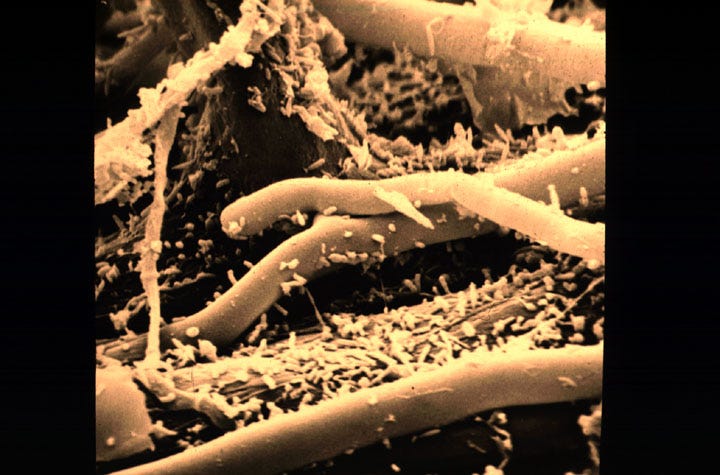
Fungi are the second soil microorganism to appear on the scene after bacteria. Fungi are less efficient at consuming simple sugars, but more adept at decomposing complex organic materials such as fibrous, woody materials. Fungi also have a wider C:N ratio, meaning that they can store far more carbon in their own biomass.
Fungi grow as filamentous strands called hyphae, and whereas the young tips of the hyphae have a rather narrow C:N ratio in line with bacteria, as the fungus grows, it stores more and more carbon back along the older sections of hyphae. This means that very old fungi can reach C:N ratios of 100:1 or more
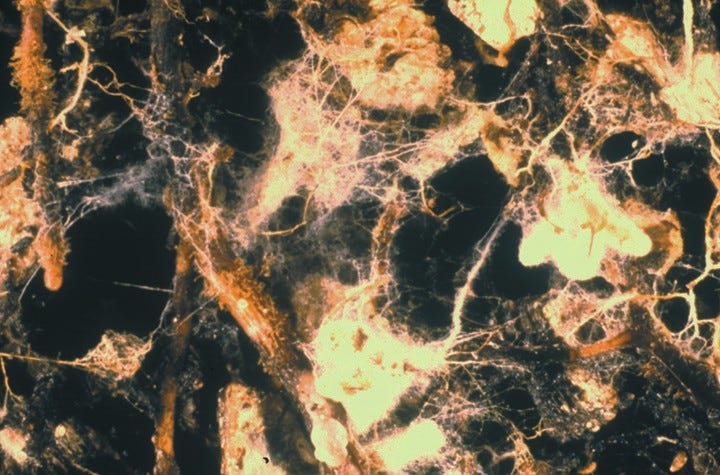
Other microorganisms in the soil such as nematodes, microarthropods, and protozoa (to name only a few of the fascinating inhabitants of the soil cosmos) consume bacteria, fungi, and each other, eventually excreting the nutrients that all of these have stored in their own bodies and making them available to plants in a readily-available form.
Returning to the problem of plowing and tilling: when farmers till soil, they disrupt this self-sustaining system and worse, when they apply chemical fertilizers and pesticides, they seriously destroy the life present in the soil. Usually, only bacteria will survive such disruptions, but because they cannot store carbon in their own bodies, it gets respired into the atmosphere as carbon dioxide in the same way that humans inhale oxygen and exhale carbon dioxide.
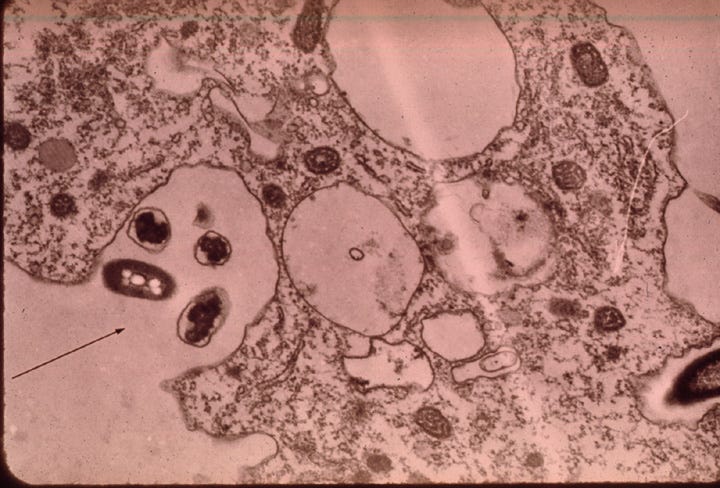
Without protozoa and beneficial nematodes to control bacteria populations, and without fungi present to capture and store carbon in their own bodies, bacteria populations can explode, quickly consuming all remaining organic matter in the soil, respiring almost all of the carbon therein into the atmosphere. Soil is transformed from a carbon sink to a carbon emitter.
On the other hand, when a diversity of microorganisms are present in the soil to control each others’ populations, and especially when fungal populations are strong, each element of the soil food web balances and sustains each other, increasing nutrient cycling.
It is important to remember that plants evolved in concert with this underground orchestra. In fact, they mostly act as the conductor, influencing bacterial and fungal populations via root exudates. No plant evolved to consume a slurry of petrochemical-based fertilizers in sterile dirt; they all evolved to interact symbiotically with soil microorganisms.
It is a worthwhile– indeed, urgent– endeavor, then, to heal our planet’s soils which have been ravished by generations of physical and chemical assaults. By eschewing intensive tilling and the application of synthetic fertilizers and pesticides, farmers can heal their soils and regenerate the vibrant subterranean communities that are necessary for truly sustainable agriculture.
Coffee, fungi, and climate resiliency
Of particular importance is the growth of healthy fungi populations. Not only do fungi efficiently store carbon in the soil, a whole class of soil fungi– the mycorrhizal fungi– develop specific, mutually beneficial relationships with the roots of plants whereby the plant feeds the fungus sugars photosynthesized from sunlight, and the fungus feeds the plant nutrients and water drawn from its hyphal network from the soil.
Only a few plant species on earth do not form mycorrhizal associations with fungi; the overwhelming majority do. Thus, while plants naturally remove atmospheric carbon through photosynthesis, it is through their association with mycorrhizal fungi that they can efficiently sequester that carbon underground in soils. Otherwise, a large proportion of that carbon would end up being cycled back into the atmosphere.

In this context, coffee is an intriguing crop, as coffea arabica originally evolved as a shrub that grew under a canopy of taller trees in the forests of Ethiopia. When we talk about coffee growing in harmony with a diverse mix of taller trees, it is usually for the benefits of the shade that these trees provide: cooler, more regulated temperatures, for example, as well as a steady stream of organic matter returning to the forest floor in the form of falling leaves.
Less often do we think about these benefits continuing underground. Yet old growth forests sustain– and are sustained by– the highest concentrations of soil fungi of any ecosystem. Therefore, coffee farmers are uniquely positioned to cultivate mycorrhizal networks on their land that will:
Capture and store water
Cycle nutrients in plant-available forms
Foster and sustain an overall more diverse, more complex, and healthier soil food web
in ways that a vegetable farmer, even farming in the most holistic way possible, simply cannot.
Mission Critical: The Soil Biota
All this considered, we at Biota place the highest priority on using coffee farming as a way to heal soils and increase climate resiliency for small farmers. Specifically, we can say that by “heal soil” we mean the regeneration of the soil biota that supports the coffee plant and all plant life on the planet. By climate resiliency, we mean the ability to weather climate extremes, especially heat and drought, by way of this same soil biota.
For most coffee farmers, however, space dedicated to shade trees means giving up space for coffee plants, and coffee plants produce coffee cherries, which is income for the farmer. And while no-till practices are more manageable for coffee trees, which almost never need to be uprooted after they are planted, it is still cheaper and easier for farmers to spray fertilizers than produce and apply compost that bolsters rather than poisons the present soil biology.
It is cheaper and easier, but only when viewed through a certain lens. While the factors around the economics of regenerative agriculture are complex, what is certain is that most farmers are not accounting for the degradation of their soil that the uprooting of native flora and the use of synthetic fertilizers causes– but that is a topic for another day.

